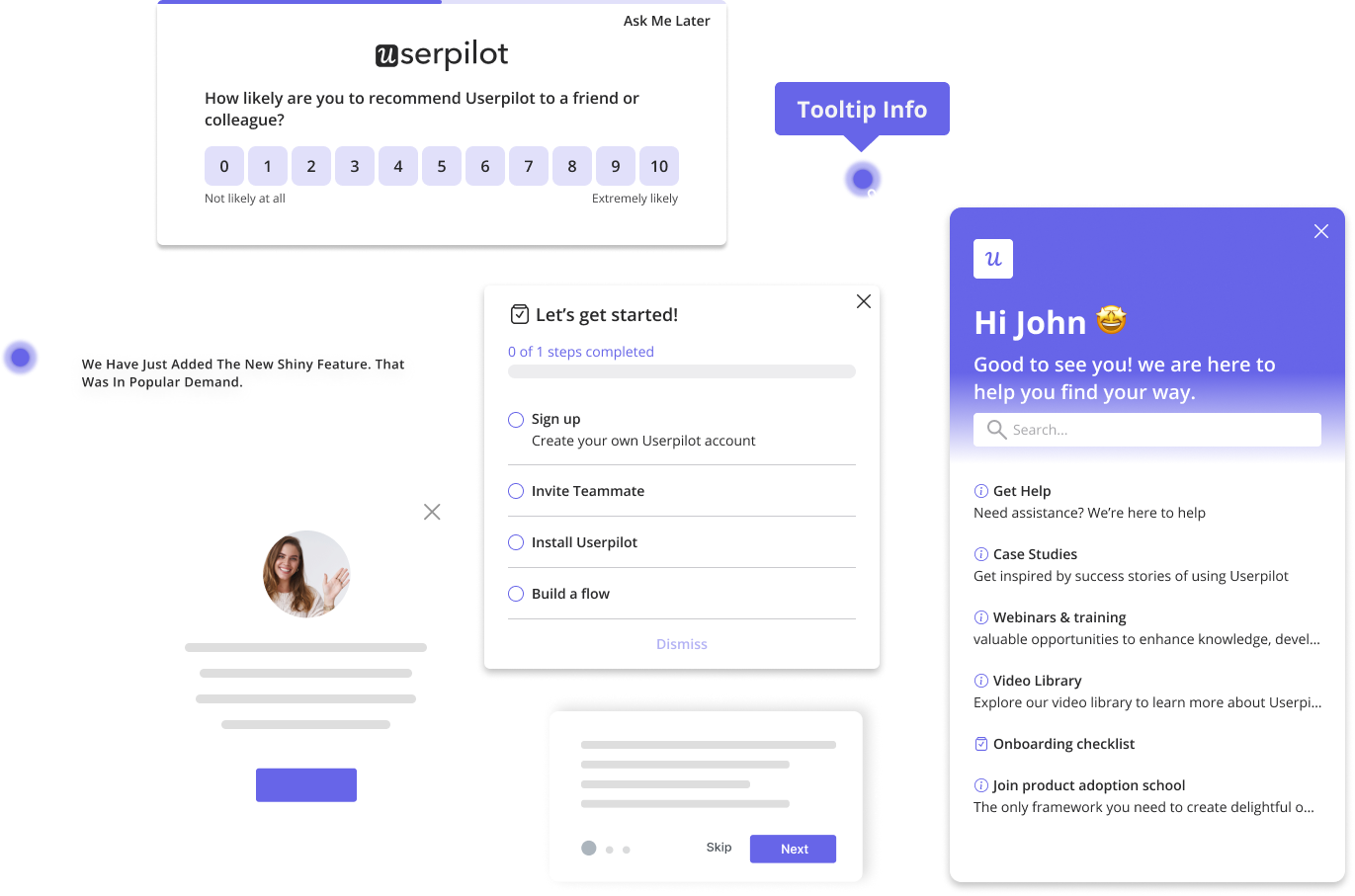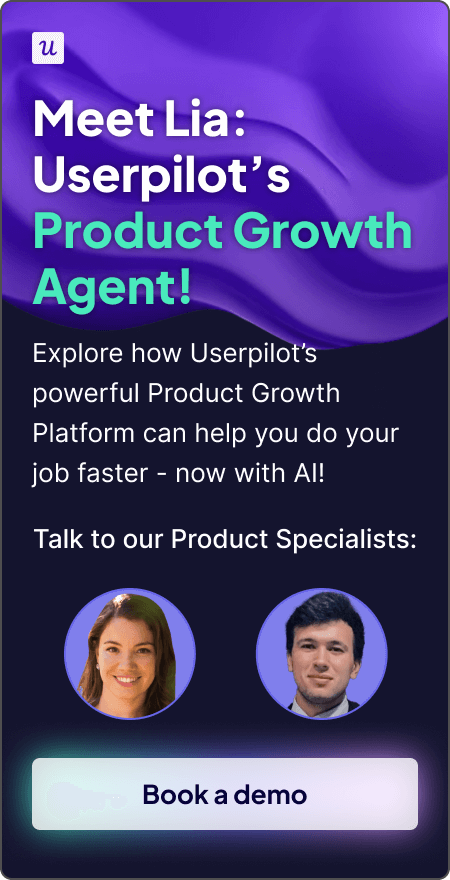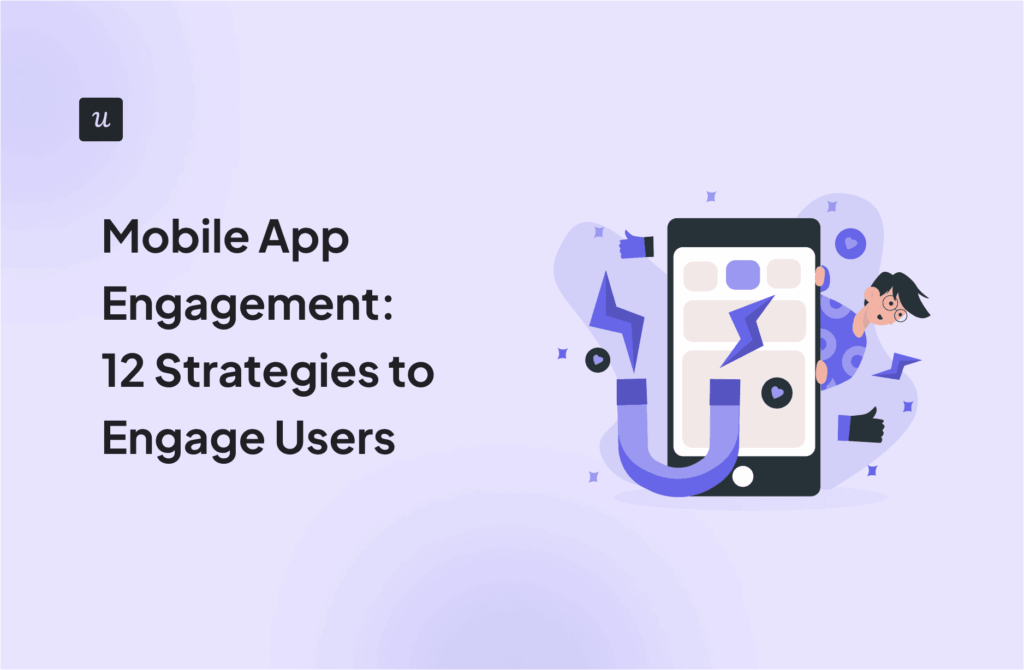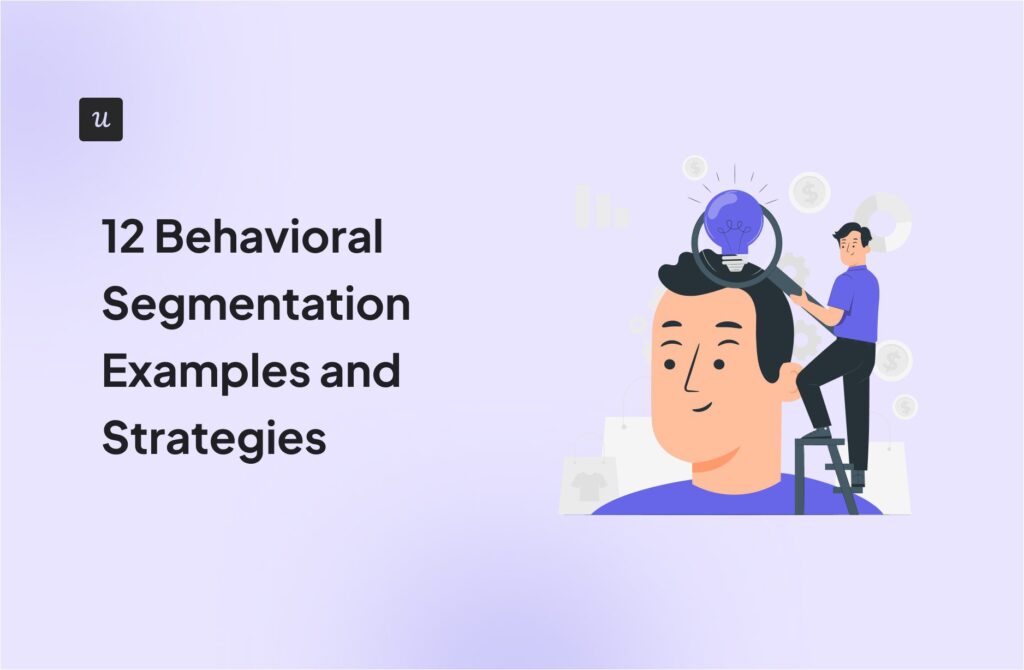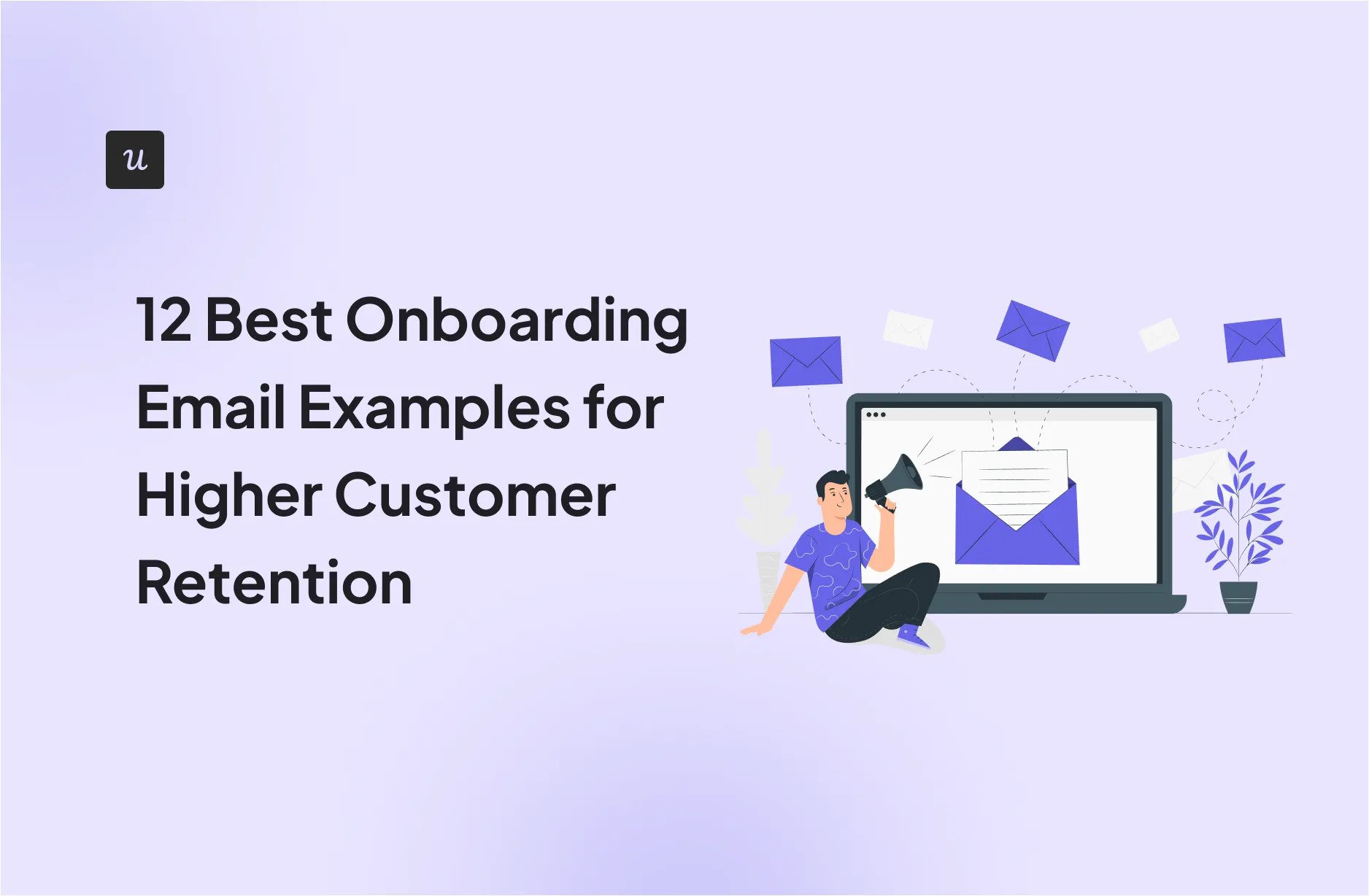
86% of customers say they’d be more likely to stay loyal to a business that invests in onboarding content that welcomes and educates them after they’ve bought. This includes writing the perfect email onboarding sequence that guides your customers through the user journey.
Here’s my quick guide to crafting stellar onboarding emails. I’ll show you the 12 best onboarding email examples I’ve seen, highlight best practices and email strategies you can implement with Userpilot to nudge users into the right actions at the right time.
Try Userpilot Now
See Why 1,000+ Teams Choose Userpilot
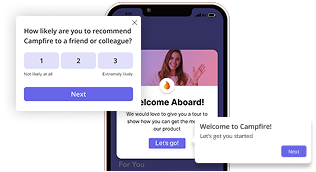
What does an onboarding email sequence look like?
Here’s a quick look at how to send a series of well-structured automated onboarding emails to keep new users engaged and educated.
- Right after a user registers, send a welcome email with a thank-you note and support resources to make them feel acknowledged from the start. Equip them with answers to their first questions in one place.
- Set up a trigger-based email that includes tips and tricks when users first use a product feature. You must help them discover your most valuable functionality at the moment they’re most curious.
- On day 3 or 4 of registration, send a friendly check-in email encouraging users to explore the platform. It helps prevent drop-off by reminding them what they’ve unlocked and how to get more out of it.
- By day 7, you can send an email asking for feedback or offering a discount code as a token of appreciation. This demonstrates that you listen and care, while incentivizing deeper engagement.
- On day 10, send an email introducing features they haven’t discovered yet with a clear CTA for upgrading or trying advanced tools, nudging them toward higher-value actions just as they settle into your product.
How Userpilot can help: Send relevant, personalized emails to your customers by segment; define how and when they should be sent, and optimize the send time based on your research.
For instance, if you have a project management tool and want to encourage new users to build their first project, you can use Userpilot to segment customers by user journey stage and location, and send a timely email reminding them to complete the specific step.
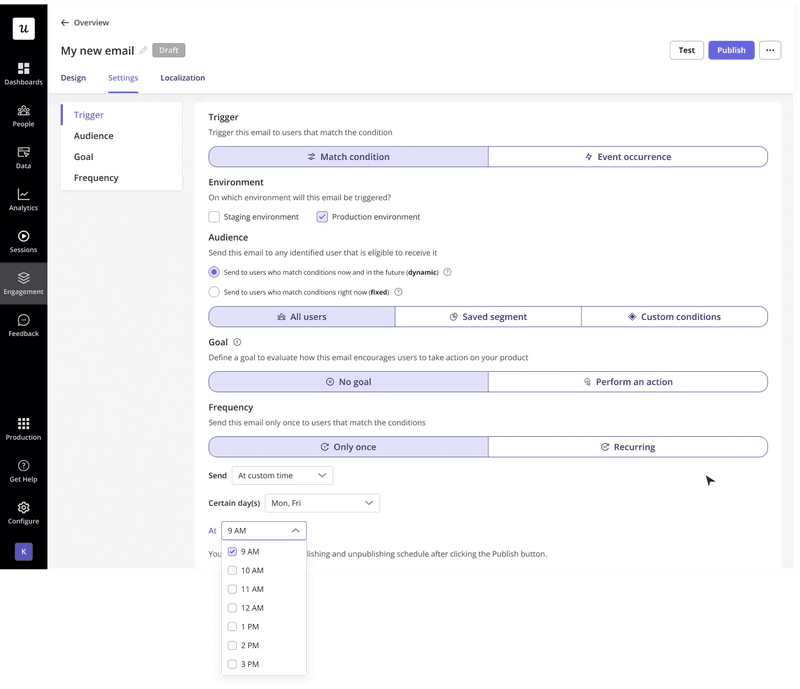
What are the common onboarding email types?
Email onboarding doesn’t mean just sending a “welcome to our tool” mail and calling it a day. You need to send a series of emails such as:
- Warm welcome email: Greet new users, share a quick-start guide, and provide links to helpful resources so they can confidently get started. This email sets a positive first impression, shows you value their time, and removes friction from those early steps.
- Nudge email: Encourage users to take a specific action, such as completing their profile, inviting teammates, or exploring a key feature. You can include a brief testimonial or mini case study to demonstrate the real benefits and turn curiosity into progress.
- Re-engagement email: Your goal should be to turn free trial users into paying customers. Remind users that their trial will end soon or offer an extended trial period, then highlight a feature they have not yet tried. A timely reminder can reignite interest and keep your product top of mind.
How Userpilot can help: Build, schedule, and send each email to the right user segment from one dashboard so every message feels personal and arrives exactly when it matters. Additionally, you can localize emails based on the region, segment them by subscription type, and also include multimedia elements such as images and videos.
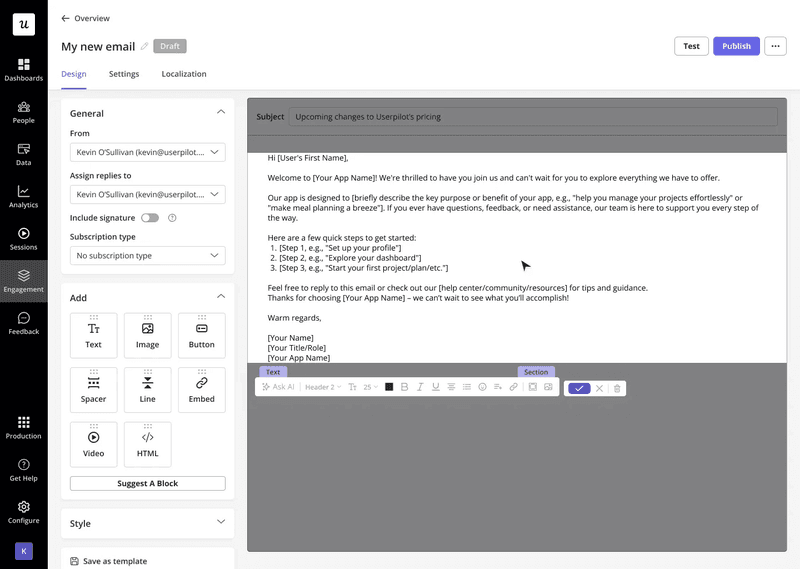
What’s the primary goal of your first welcome email in an onboarding sequence?
How do you best encourage users to try a key feature they haven’t discovered yet?
What’s the most effective strategy for optimizing your onboarding email examples for higher retention?
You’re on the right track to creating the best onboarding email examples!
You understand that effective onboarding isn’t about sending generic blasts. It’s about sending the right message, to the right user, at exactly the right time.
Userpilot makes it easy to trigger personalized, behavior-based emails to guide users, increase feature adoption, and boost retention.
12 Best onboarding email examples + best practices
I’ve sent and received many onboarding email sequences over the years, and there’s a ton of nuance that goes into creating an email that drives your click-through rate and product adoption. I’ve compiled some of the best onboarding email examples I’ve come across, which stand out because of their structure, copy, and subject lines.
Here’s what makes them so great, and how you can implement the same in your onboarding strategy:
1. ClickUp
ClickUp’s welcome email helps users get started with the product by introducing their key features.
However, the email runs too long, and users might lose interest halfway through reading it. You must keep your email informative, but not so much that users feel overwhelmed and click away.
What’s good?
The email is comprehensive, giving new users everything they need to get started with the product. They share their “university,” product demo, and a link to join their Facebook community. It’s a good way to learn about the product and interact with other power users as well.

Key takeaway
Give users multiple options for learning about your product. While some are visual learners and prefer videos, others may prefer to read about it.
2. Grammarly
Grammarly sends out a note from their founder as soon as someone chooses to upgrade to its premium plan. In it, he thanks you for trusting Premium, shares his vision, and explains how he understands your goals, while offering future tips about making the most of the product.
While the message is positive, I’d improve this with one tweak: embed a video from the founder explaining what users can expect from their premium subscription to provide a more personalized experience.
What’s good?
The email immediately shows users that their team values helping you make the most of their product. It also gives you a heads-up about the upcoming emails they’ll send so you don’t press “Unsubscribe.”
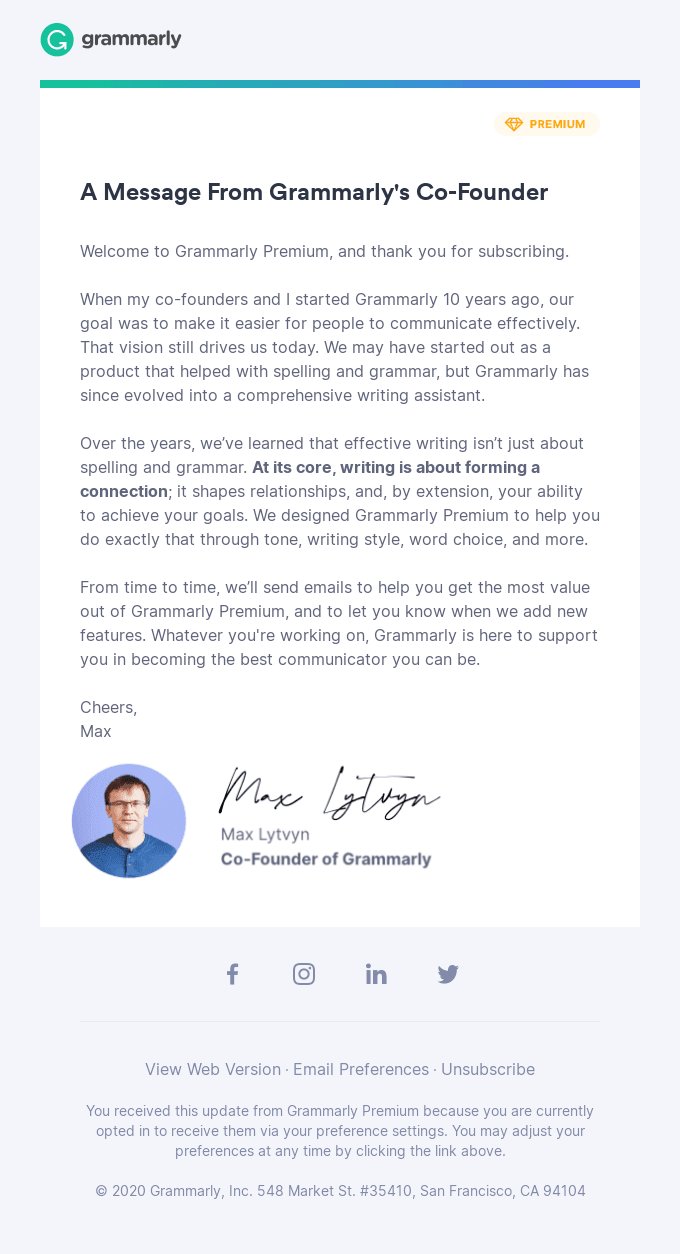
Key takeaway
Most users don’t like their inboxes flooded with emails from brands. When you give them a sneak peek of what’s to come, they’ll actively look for tips on how to use your product better.
3. Loom
Reminding your customer of your product value shouldn’t just be a one-off activity. You can use onboarding emails as a way to remind customers how you’ve improved their lives.
Loom stands out here because it gives me a sense of accomplishment every time I see how much time I’ve saved by viewing recordings instead of setting meetings.
What’s good?
Most brands send emails about how to use the product, but very few show how you’ve benefited from them. Loom hasn’t just summarized how you use their platform, but also how many people on your team engage with it, proving that it’s a must-have tool for the entire organization.

Key takeaway
After people sign up, send them regular updates about how your product has helped them. It highlights your unique value well and encourages users to try other features as well.
4. Calendly
Calendly keeps their welcome email simple by sending a concise and no-frills email that tells users what they can expect from the platform.
A couple of things they can improve are:
- Show images of the commonly used features so users know what to expect.
- Highlight the option to access the video tutorial series more clearly, as most users won’t scroll to the end to find it.
What’s good?
They immediately describe the benefit by stating that users could save 208 hours a year. It also creates a custom link for you to share immediately, making it easy for busy users like me to share the link with anyone I want to book a meeting with.
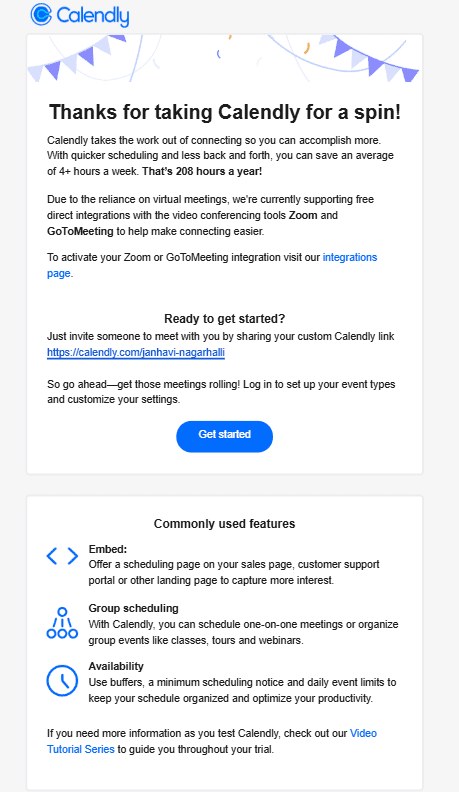
Key takeaway
The average read time for emails today is just 9 seconds, which isn’t a lot! If you don’t capture your customer’s interest, they will bounce. When writing emails, follow the KISS principle (Keep it Short and Simple) so you don’t lose customers’ attention and get them to take action as soon as possible.
5. Notion
When users sign up, they don’t always complete the onboarding process. Notion does a good job by recapping your first week’s activity in an email to create a sense of progress and accomplishment.
My suggestion for improvement would be to add some personalization here. A simple “Hey <name>” and a catchy subject line go a long way.
What’s good?
They included a simple onboarding checklist in the email so users know what’s left on the list. Plus, “Pick a template” is a strong, action-forward CTA that immediately compels users to return to the product.
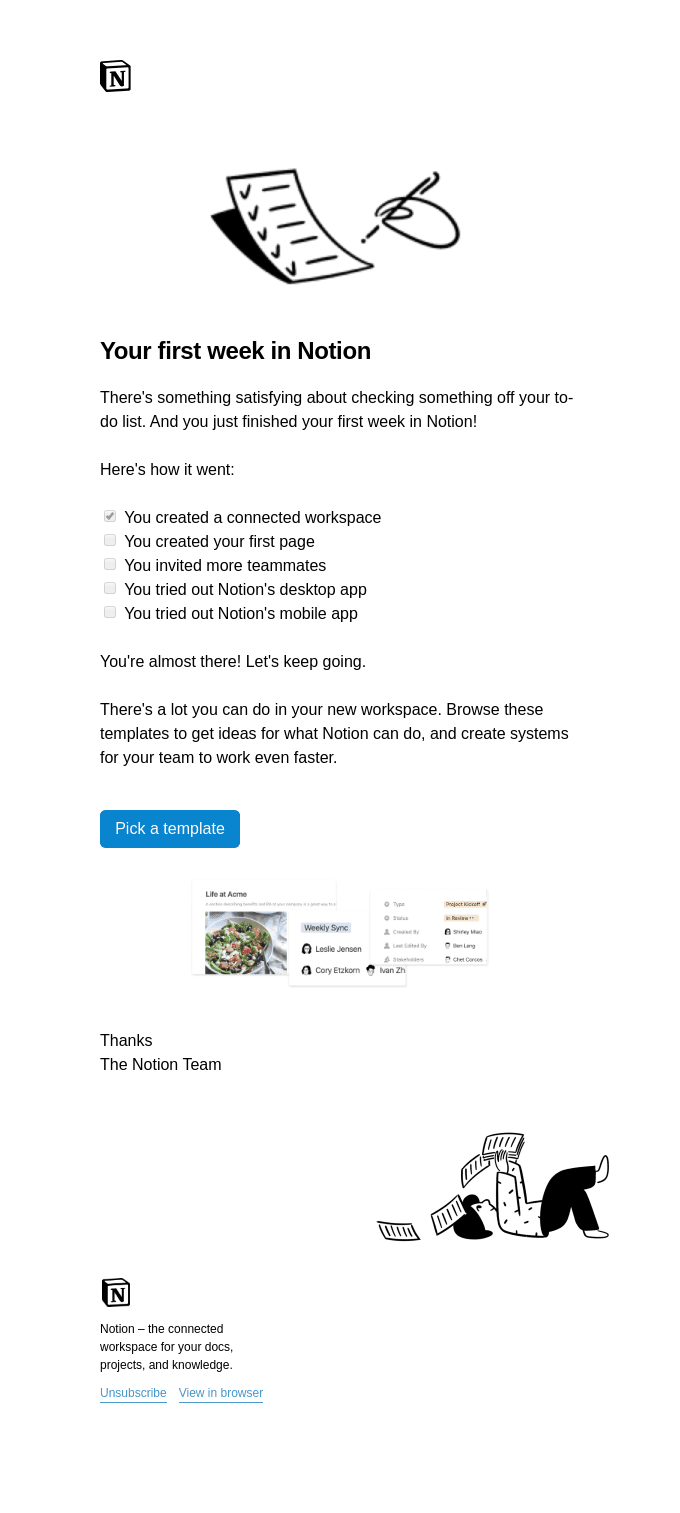
Key takeaway
Your users never finish onboarding in one go, and that’s okay. Make sure to nudge them subtly into trying your core features so they can quickly reach their “Aha!” moment.
6. Blaze AI
Sometimes you find a great SaaS product and begin to sign up for a trial, but forget to complete registration. If you want to capture those “almost-users,” take a page from Blaze’s playbook.
However, I believe the subject line “Get everyone talking about you” could be better. You could drive more urgency with a line like “Create better content than your competitors with AI.”
What’s good?
The email is concise and to the point, quantifying the benefits of using their product immediately, so users know how much time they can save while still prioritizing quality content creation.
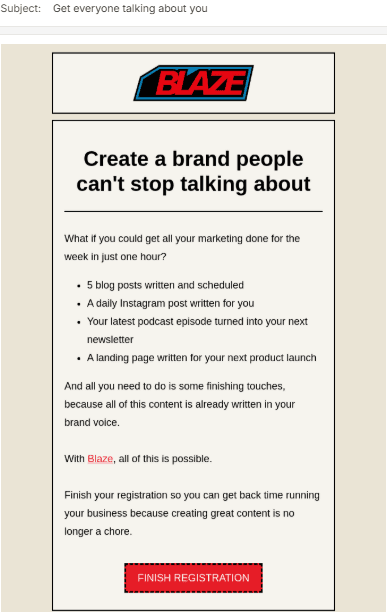
Key takeaway
According to Drip, the ideal email length is less than 100 words. You must send concise emails explaining your USP right off the bat to compel users to sign up for your product.
7. Bitly
Who says onboarding emails have to be boring? Bitly does a great job summarising its product and use cases in a fun little poem.
However, adding a few feature images or GIFs could be helpful here because, as a user, I’d like to visualize the product. Plus, the subject line “Hi” can cause users to ignore the email. It’s best to have an email subject line that’s eye-catching and intriguing. One example is “Shrink URLs quick, make people click”, which also gives a sneak peek into the rhyme.
What’s good?
The copy here is catchy, clear, and playful, which can amuse users and build brand affinity. They also include a “usage tracker” to help them understand when they’re close to their usage limit.
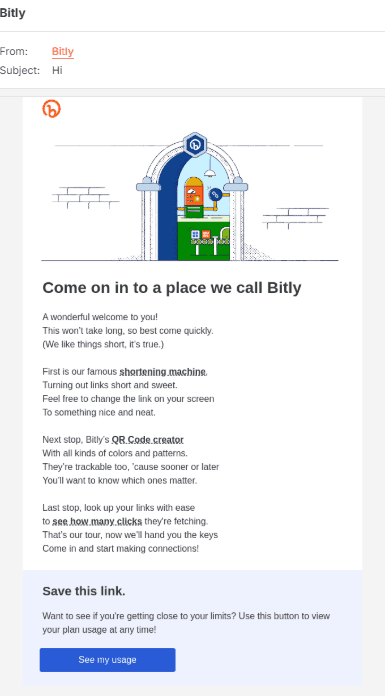
Key takeaway
Make your onboarding emails informative and enjoyable to read. Users tend to remember little things, such as a creative rhyme, which can motivate them to explore your features right away.
8. Canva
Canva is one of the best onboarding email examples on this list in terms of design. The CTA is clear, actionable, and helps users learn about the product in just one click.
However, I did spot a couple of areas of improvement, such as:
- They could include another fold that allows your customers to contact customer support in one click, in case they have any questions.
- They could add only one step in their “starter pack” because adding four different options could confuse users about what to do first.
What’s good?
As a design tool, Canva knows how to create killer email designs. The font, colors, and elements perfectly match their branding, making the email look visually appealing.
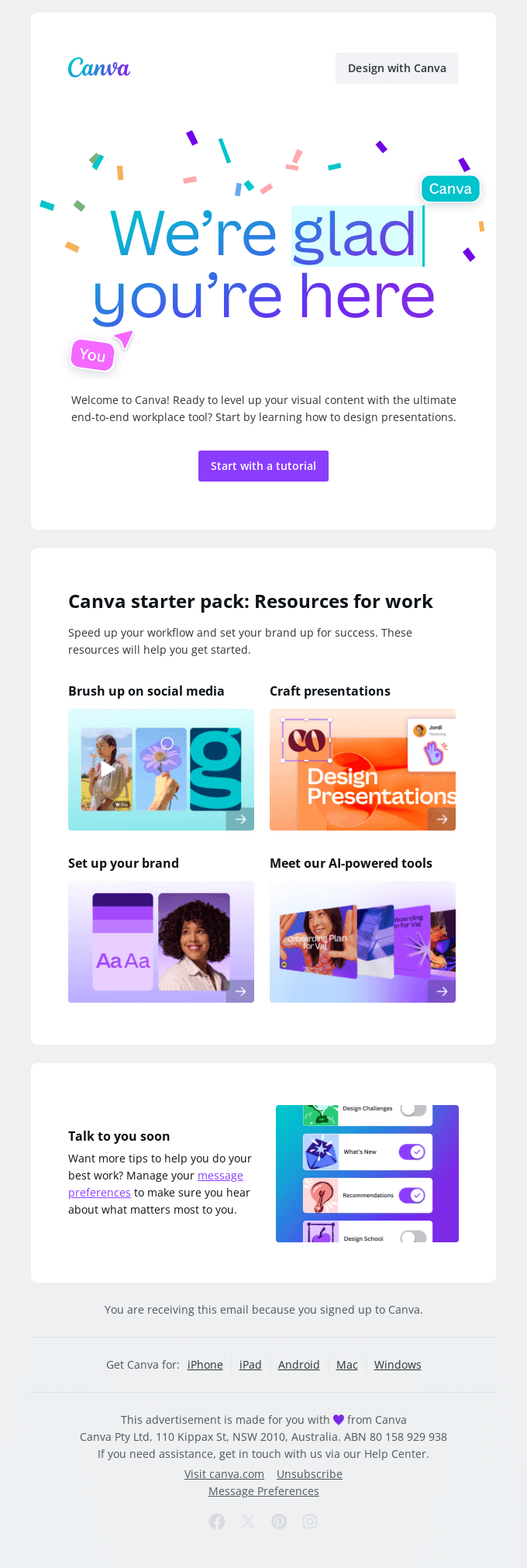
Key takeaway
Tailor your email design to match your brand assets. If your website has a whimsical look, make sure that your onboarding emails follow the same pattern.
9. Zoho Creator
Users don’t often keep track of when their free trial is ending, and an email is a great reminder. If you want to onboard trial users to a paid plan, try Zoho’s approach.
However, I feel that the “UPGRADE NOW” CTA is quite generic and could be replaced with something like “Continue creating awesome apps” to keep them curious.
What’s good?
They show users what they’d be missing out on if they don’t upgrade to a paid plan. Additionally, the customer success manager provides guidance on selecting the most suitable pricing plan tailored to the user’s specific needs.

Key takeaway
Convert free trial users into paying customers by segmenting your email list correctly and sending them targeted emails at the right time. You can drive urgency like Zoho by emphasizing when the free trial ends, and also build FOMO by showing how they’ll miss out on important features they’d need to make the most of your product.
10. Riverside
Riverside’s welcome email provides customers with a list of best practices to follow before using their platform, to help them record the best first video, without any interruptions or chaos.
What’s good?
They clearly outline what your trial period includes and have included helpful videos within the email to assist users in getting started with the platform. They also provide links to their blog and knowledge base for users who prefer to read instead.
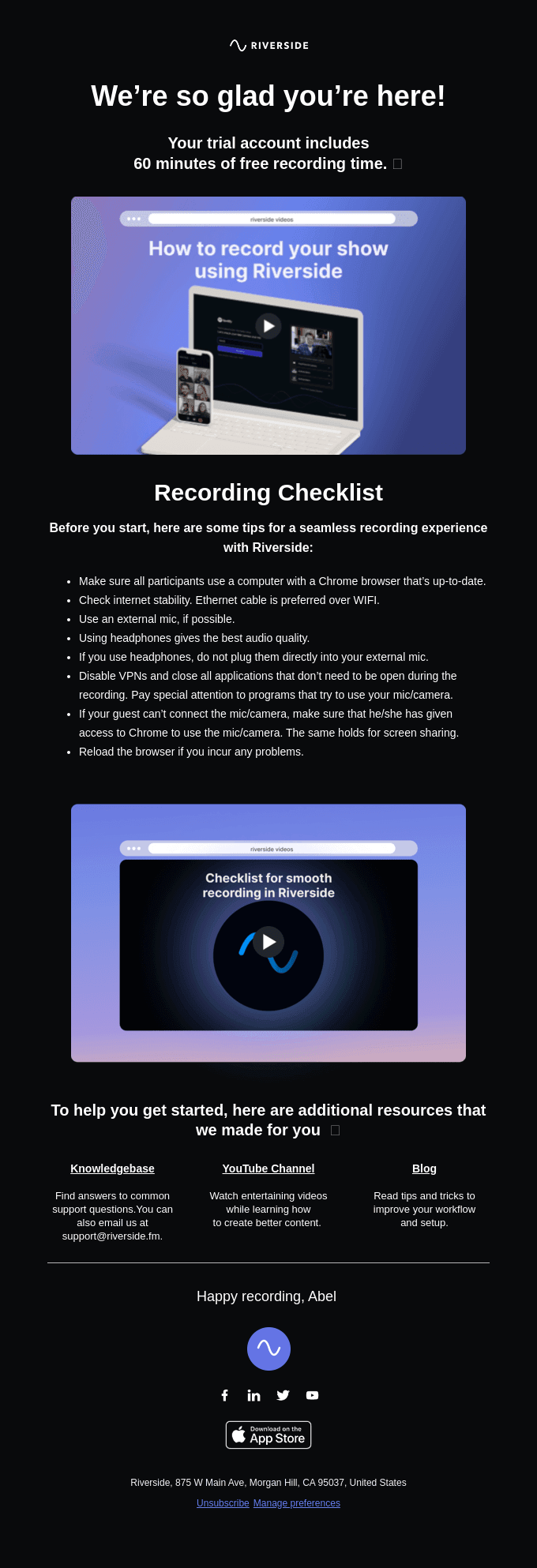
Key takeaway
Provide users with a mini-checklist on how to make the most of your platform directly within the email, before they start using the tool and encounter an issue.
11. Zapier
Zapier’s onboarding email, sent after completing an action within the product, is one of the best email onboarding examples in terms of keeping users engaged throughout the customer journey.
What’s good?
They celebrate the first milestone after using the product, and also personalize the email by addressing you by name. It creates familiarity and also motivates users to explore your tool further.
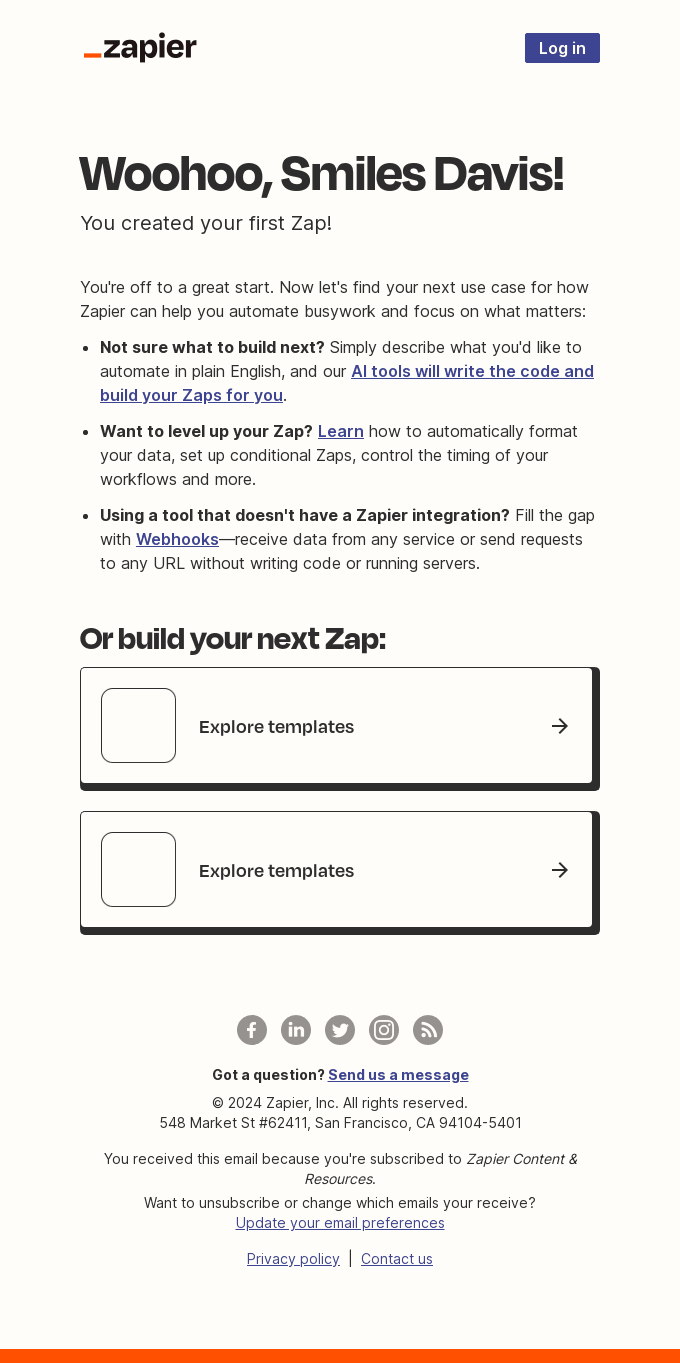
Key takeaway
Personalize your onboarding emails by adding the recipient’s first name and suggesting new actions they can take within your product.
12. Wistia
Wistia’s check-in email, reminding me to upload a video, is a masterclass in writing subject lines. They use a fun joke setup: “What do you call a dog with a surround system?”, and pique their customer’s curiosity to open the email and find the punchline, thereby cleverly increasing their open rate.
My only suggestion here is to reduce the number of CTAs again. I believe the “Sign up for a demo” CTA is an extra button that could confuse users.
When it comes to a reminder email, keep the CTAs to a minimum.
What’s good?
Their subject line is the opening to a good joke, which compels the user to click the email and find the punchline. They also humorously write about the need to complete the key action (in their case, uploading a video), accompanied by an adorable picture of a dog. And of course, they complete the joke in the end, making sure that the user scrolls through the whole email.
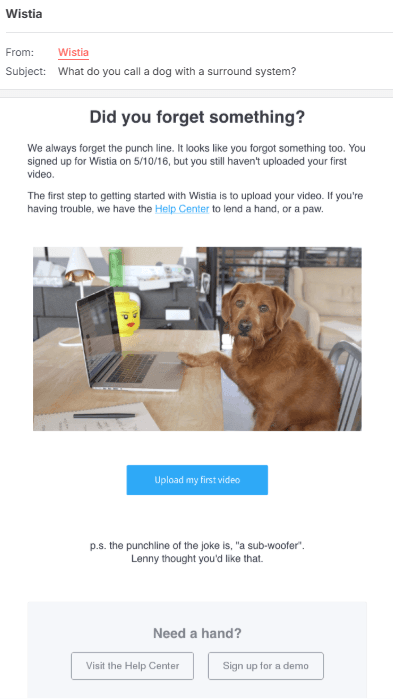
Key takeaway
Spend as much time on the subject line as you do on the rest of the email. If you send a generic “Welcome to X” subject line, users might mark it as read and ignore it. I suggest using a free subject line optimizing tool like Omnisend to create a subject line that’s both intriguing and aligns with the intent of your email.
Set a positive tone with your welcome messages
When your welcome emails feel warm, clear, and genuinely helpful, you turn one-time sign-ups into engaged advocates. Userpilot lets you personalize those messages, test different tones, and automate send times so every new user feels seen and supported.
Ready to discover how a tailored welcome sequence can boost your customer retention? Book a demo with Userpilot and start creating welcome emails that set the stage for long-term growth.
FAQ
How do you introduce yourself in an onboarding email?
Try this template:
Subject: Welcome to [Product Name]—I’m [Your Name]
Hi [First Name],
I’m [Your Name], [Your Role] at [Company]. Thank you for choosing [Product Name]. To help you get started, I’ve linked our [Quick Start Guide] and a few tips on features you will love:
• [Feature A]: [One-line benefit]
• [Feature B]: [One-line benefit]
If you have any questions or would like a live walkthrough, please reply to this email or book a time with me here: [Calendly Link]. Looking forward to working with you,
[Your Name]
[Title],
[Company]
[Profile Photo] | [LinkedIn] | [Website]
How to write an onboarding email?
Use this template to write a welcome email for your product:
Welcome to [Product name]
Ready to handoff more than specs? With [Product name], you get a structured workspace to publish designs, where the entire team can come together to ship beautiful products.
Everything starts when a designer publishes finalized designs to [Product name], so developers, copy writers, product managers, and more know exactly what to build. Adding Commit Messages helps clarify exactly what has changed between versions.
Let’s get you started! Use your favorite design tool to publish your first design to [Product name]:
- Creating designs
- Publishing designs
- Reviewing designs
- Implementing designs
We hope you have a great experience using [Product name]! If you have any questions along the way, just reply to this email.
Cheers,
[Product name] team
PS. Want more tips? Search through more:
[Button] Frequently Asked Questions
How do I follow up on the onboarding process email?
Try this template:
Subject: Want to make the most of [Product Name]?
Hi [First Name],
I wanted to follow up on the email I sent after you signed up for [Product Name]. By now you’ve probably tried [Key Feature]—did it help you [Benefit]? If you hit any snags or have questions, just reply to this email or grab a spot on my calendar: [Calendly Link]
Here are a few resources that might help:
[Feature Guide]: Step-by-step walkthrough of [Key Feature]
[Video Tutorial]: Quick demo in under 3 minutes
[Help Center]: Answers to common questions
If you’re ready for a deeper dive, let’s set up a 15-minute call to tailor [Product Name] to your workflow. Looking forward to helping you get the most out of [Product Name],
[Your Name]
[Title],
[Company]
[Profile Photo] | [LinkedIn] | [Website]

